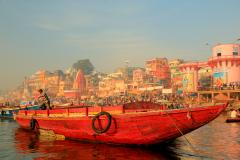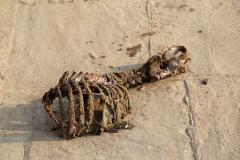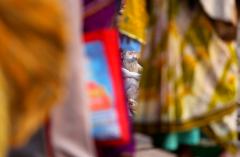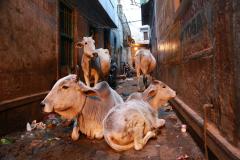10 days in Varanasi, but not so much there
Dead bodies, cremations, holy Ganga, cows, cows, cow shit, and exile in Brown Bread Bakery
By now I’ve been in Varanasi, alias Benares, alias Kashi, alias City of Life (although in reality it has closer to City of Death) for 10 days, making it my longest presence in one place during my journey. Surprisingly, that does not mean that I would know the city inside out, or that I would have here a blast. I mostly stayed here, because I needed a break from my travels, which were quite busy last few weeks, I needed to recuperate from the disease souvenir from Kumbh Mela (and I’m still not quite there), and finally, I have a reliable internet connection in my room.
I’m surprised myself, how little time I have actually spent in the city. Also, I haven’t taken a single photograph for more than a week after my arrival, and Varanasi is one of the best photo destinations on the planet. Maybe the key lies in the fact that I have been in Varanasi already, 4 years ago. This is the first place on my travels, where I had been before. So I was not really in hurry here, and decided to take it easy. Also, as my stomach was all messed up, I switched to western diet here, and I spend most of my time in a wonderful place called Brown Bread Bakery, where they have REAL bread, all sorts of bread – baguettes, ciabattas, rolls, … – sinfully good meat (I had Cordon Bleu in Varanasi, who would have thought…), great live music every evening and nice community of backpackers hanging around.
Some encyclopedic facts about Varanasi, because this city deserves it:
Varanasi, said to be one of the oldest cities in the world, is the most sacred city for Shaivites, worshippers of Shiva, and basically the most sacred city in India as such. Apart from being the City of Shiva, Varanasi is the place where Hindus go to die. Pilgrimage to Varanasi – a must-do for Hindus – is often their last pilgrimage of their lives, because old and ill people, who feel that they will die soon, flock to Varanasi to live here their final days (or weeks, or months, or years…) and die their final death. The final death – that’s the point. Similarly as bathing in Ganga/Yamuna during Kumbh Mela, dying in Varanasi offers immediate moksha, liberation from the cycle of reincarnations, the ultimate goal of each Hindu. Unlike Kumbh Mela, which gives this priceless opportunity only once in 12 years, Varanasi is open year round. But, the trick is, that you have to die here. That’s the reason, why those about to die come here and wait for the death.
But there’s more. After you die in Varanasi, they wrap you in a cloth, put some flower garlands over you, dip your dead body in Ganga and then publicly cremate your body at one of the “burning ghats”, public places at the banks of Ganga. At any given moment, there are at least 4 people burning on giant pile of wood – it looks like some satanic bonfire to us, the westerners. At first the corpses are covered by cloth, so you do not see the dead bodies, but when the cloth burns through, you see all the details that this theater of death has to offer: burned faces, exposed rib bones and hips as the chest turns into ashes, arms and legs detached from the body, leisurely situated on the top of the body, … Designated workers of death take care of dipping the body into Ganga, stocking up the wood for fire, laying the body atop of the wood, starting the fire and, using bamboo sticks, for moving around the wood as it burns, and the arms and legs, as they fall off the body. Sometimes they pierce the chest to facilitate the cremation of the body. When only ashes remain, they throw them into Ganga. Buying the wood for the cremation is not cheap and many cannot afford sufficient amount of wood, and so the unburned remainders of their bodies are simply thrown into the river. I saw how 2 men in a boat took a dead body, paddled to the middle of the river, and dumped it into the river as it was, without any burning. When I was here 4 years ago, one of the guides to the rituals (who work for tips) told me that people who die because of snake poisoning are not cremated, because they are not “properly dead” they are sort of sleeping endlessly. Neither are pregnant women. They are thrown into the river without the cremation. And neither are people who died from leprosy, because leprosy is spread through the air, when the body is cremated. And so what do they do with people who died from leprosy? Yes, your guess is right, they dump them into the river. By this way the leprosy will SURELY NOT be spread… Real triumph of Indian logic!
I forgot to mention, that apart from dying and burning, Varanasi is very popular place for bathing in Ganga, again to clean your sins, and attain moksha - you know the story by now. And so thousands of people, daily bath in the river, with parts of corpses or whole dead bodies flowing around them. Not even mentioning the heaps of dead animals in the river. Frankly speaking, I have never seen any more disgusting body of water than Ganga in Varanasi, but the immunity system of locals is unbelievable and so they can bath and actually survive it. Lonely planet states, that the safe norm for bathing in the river (bathing, not drinking) is 500 fecal bacteria per 100ml. Ganga in Varanasi has value of, wait for it, 1,5 million fecal bacteria per 100ml. That’s “only” 30 000 times more than the norm. I guess I don’t have to mention, that the locals not only bath in the river and wash their clothes, they also clean their teeth and drink it. Wow! I wish I had Indian immunity.
So, yes, of course that I did go to see few cremations (and be sure that the wind blows the smoke and ash from the dead bodies right into your face), I did walks along the river to see the bathing and washing and praying, I did walk through the cows-congested streets (the ancient streets of the old town are too narrow for traffic, but the alleys are homeland for hundreds of cows who freely roam here and shit here – Varanasi is surely most cow-shit polluted city in the world), I did take the boat trip, but most of the time I stayed in exile of my room and Brown Bread Bakery. Unlike 4 years ago, the ritual of death does not fascinate me that much anymore, and I prefer reading to watching the holy bonfires.
Very appropriately, like for many Hindus for whom their pilgrimage to Varanasi in their last one, it’s mine last Hindu pilgrimage as well. I started off in holy city of Rishikesh, joined pilgrims in Madurai and Rameshwaram, passed through Kanyakumari, attended Maha Kumbh Mela and reached Varanasi , and here I am finishing my Hindu circle. Now begins my Buddhist circle. I’m going to Sarnath – place where Buddha preached his first sermon after attaining enlightenment, then to Bodhgaya, where he attained the enlightenment and from there, with short stopover in world’s tea icon Darjeeling, I’m heading towards Himalayas and Nepal, world’s number 1 Buddhist stronghold (together with Tibet). I’m suspiciously precisely following the story of Hesse’s Siddharta, who started as Hindu shraman (ascetic pilgrim/hermit), then followed Buddha and then… well, no need to jump fast forward.





